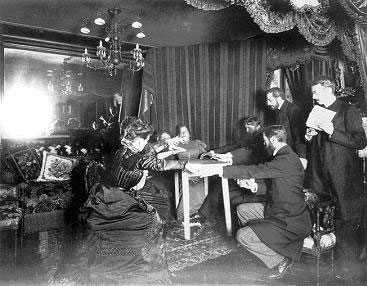
Eusapia Palladino during a seance
In an hour-long program devoted to “Music from the Dead Composers,” the self-possessed Miss Brown played several selections she had received by creative notables of the past. Humphrey Searle, an expert on the music of Liszt, described one of her transmitted offerings as something that may well have been written by Liszt, especially during the last fifteen years of life. “Yet,” he added the caveat, “it did not resemble any piece I know.” Presuming it was an original composition would not be unexpected. He remarked on the fact that it was in five-four time, uncommon to the 19th Century, yet the mood was of that period and “the full design of the piece is quite Lisztian.”
The great Hungarian composer [27] also had given her a new musical scale and Brahams a series of fingering exercises, although she thought the latter dull. Skelton then commented on a piece for strings by Brahams which she had received recently, observing that the viola part had been written by her an octave lower than it should have been. Nevertheless, when performed by the Darlington String Quartet, it elicited very positive responses.
A psychic investigator, Rosalind Heywood, who was a former concert pianist, was present, with the program’s principal, Geoffrey Skelton, at the medium’s home, when she received a “new” composition from Liszt. As to explain the phenomenon, she suggested the “personal subconscious because of frustration.” The theory was also offered that once music had been played it existed forever in the universe and that a sensitive might pick up such melodies telepathically.
The Psychic News carried a commentary by the noted English musician Roy Douglas. It said, in part:
I found the longer Liszt piece and the Brahams fragment for string quartet entirely convincing. It seems extremely unlikely that she would be so familiar with Braham’s chamber music as to be able dishonestly to concoct anything so essentially similar to his string writing. It also had a touch of wistfulness so typical of Braham’s quartet writing, a distinctive quality which I am positive could not have been fabricated by a woman of such limited musical ability. . . I consider it almost certainly impossible for her to have invented an imitation of these late works because: (a) they are very rarely heard; (b) few copies are in existence; and (c) comparatively few professional musicians would be sufficiently familiar with them to be able to compose imitations. … If spurious, they could only have been faked by a musician of considerable knowledge and experience. … Therefore I am quite certain that neither of these two pieces was deliberately or unintentionally faked by Mrs. Brown’s unconscious mind. Nor could she have invented them by merely sitting at the piano and twiddling the keys, hoping to produce something which would sound like Brahams or Liszt. If one is determined to account for her work in terms of the mundane, there are only two absurd theories I can think of: a sealed parcel, arriving at her home now and then, containing a manuscript from a clever and dishonourable musician with the message, “Here is my latest imitation of…” [or] the same dishonourable musician, in a Svengali-like cloak and mask, [28] hypnotizing Mrs. Brown and dictating his fabrications to her in a trance.” Failing these … they are coming from the composers themselves. [29]
She was carefully studied by the late pianist and musicologist Stewart Robb, who was also an authority on spiritualism, and found to be convincing. That is, he concluded that authenticity was more likely than mere verisimilitude. He provided the author with tapes of the compositions [30] who was not sufficiently musically schooled to render a useful opinion as to whether they were the work of Mrs. Brown.
27 Franz Liszt, (1811-1886), greatest pianist of his time and major composer; married, had three children; and, in 1865, joined the Franciscan Order of monks. He wrote in most musical forms except opera. Back to text
28 One wonders if he is thinking of the mysterious visitations Mozart received just before his death. Back to text
29 The Psychic News. Psychic Press, Ltd. 23 Great Queen Street, London W.C.2. Number 1953. November 8, 1969. p. 8. Back to text
30 About an hour long on reel-to-reel, still in author’s possession. Back to text

